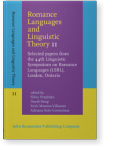References
ALF=Gilliéron, Jules & Edmond Edmont. Atlas Linguistique de la France, Paris, Champion, 1902–1910.
ALAL=Potte, Jean-Claude. Atlas Linguistique et ethnographique de l’Auvergne et du Limousin, Paris, CNRS, 1975–1992.
ALLOc=Ravier, Xavier. Atlas Linguistique et ethnographique du Languedoc Occidental, Paris, CNRS, 1978–1994.
ALG=Séguy, Jean. Atlas Linguistique et ethnographique de la Garonne, Paris, CNRS, 1954–1973.
THESOC=Dalbera, Jean-Philippe, Dominique Strazzabosco, Michèle Oliviéri, Pierre-Aurélien Georges & Guylaine Brun-Trigaud, Thesaurus Occitan, <[URL]>, 1992.
Béjar, Susana. 2003. Phi-Syntax: A Theory of Agreement. PhD. thesis, University of Toronto.
Bruhn de Garavito, Joyce, Jacques Lamarche & David Heap. 2002. “French and Spanish Se: Underspecified, not Reflexive.” 2002 Proceedings of the Canadian Linguistic Association.
Burzio, Luigi. 1992. “On the morphology of reflexives and impersonals.” In Theoretical analyses in Romance linguistics. Current issues in linguistic theory 74, ed by Christiane Laeufer & Terrell A. Morgan, 399–414. Amsterdam: Benjamins.
Cabredo Hofherr, Patrizia. 2000. La passivation des intransitifs en allemand et le statut des explétifs. Paris: Université Paris VII – Denis Diderot, U.F.R. de linguistique.
Cabredo Hofherr, Patrizia. 2004. “Les clitiques sujets du français et le paramètre du sujet nul.” Langue Française 141: 99–109. 

Chomsky, Noam. 1981. Lectures on Government and Binding. The Pisa Lectures. Second revised edition 1982. Dordrecht: Foris.
Dalbera, Jean-Philippe. 2006. Des dialectes au langage: Une archéologie du sens. Paris: Champion.
Dalbera, Jean-Philippe, Michèle Oliviéri, Jean-Claude Ranucci, Guylaine Brun-Trigaud & Pierre-Aurélien Georges. 2012. “La base de données linguistique occitane THESOC. Trésor patrimonial et instrument de recherche scientifique.” Estudis Romànics 34: 367–387.
Diémoz, Federica. 2007. Morphologie et syntaxe des pronoms personnels sujets dans les parlers francoprovençaux de la Vallée d’Aoste. Tübingen: A. Francke Verlag.
Gilliéron, Jules & Jean Mongin. 1905. “Scier” dans la Gaule romane du Sud et de l’Est, Paris: Champion.
Harley, Heidi & Elizabeth Ritter. 2002. “Person and number in pronouns: A feature-geometric analysis.” Language 78: 482–526. 

Heap, David. 2000. La variation grammaticale en géolinguistique: les pronoms sujets en roman central. München: Lincom Europa.
Heap, David & Michèle Oliviéri. 2013. “On the emergence of nominative clitics in Romance dialects.” Paper at the Workshop European Dialect Syntax VII, University of Constance, 13–15 juin 2013.
Kaiser, Georg A., Michèle Oliviéri & Katerina Palasis. 2013. “Impersonal constructions in northern Occitan.” In Current Approaches to Limits and Areas in Dialectology, ed by Xosé Afonso Álvarez Perez, Ernestina Carrilho & Catarina Magro, 345–366. Cambridge: Cambridge Scholars Press/CSP.
Manzini, M. Rita & Leonardo M. Savoia. 2005. I dialetti italiani e romanci: morfosintassi generativa. Alessandria: Edizioni dell’Orso.
Meyerhoff, Miriam. 1997. ‘Be I no GAT’: constraints on null subjects in Bislama. Philadelphia: University of Pennsylvania Thesis.
Oliviéri, Michèle. 2010. “From Dialectology to Diachrony: Evidence from Lexical and Morpho-Syntactic Reconstruction in Romance Dialects.” Proceedings of Methods XIII. Papers from The Thirteenth International Conference on Methods in Dialectology, 2008, ed. by Barry Heselwood and Clive Upton, 42–52. Frankfurt: Peter Lang.
Oliviéri, Michèle, Georg A. Kaiser, Michael Zimmermann, Katerina Palasis, and Richard Faure. à paraître 2015. “Quand la dialectologie, la diachronie et l'acquisition se parlent : Étude comparative des pronoms sujets en occitan et en français.” In SyMiLa 2015: La microvariation syntaxique dans les langues romanes de France, ed. by Patrick Sauzet, and Jean Sibille. Limoges: Lambert Lucas.
Palasis, Katerina. 2010. Syntaxe générative et acquisition: le sujet dans le développement du système linguistique du jeune enfant. Villeneuve d’Ascq: ANRT Diffusion.
Renzi, Lorenzo & Laura Vanelli. 1983. “I pronomi soggetto in alcune varietà romanze.” In Scritti linguistici in onore di G.B. Pellegrini, 42–56. Pisa: Pacini.
Ronjat, Jules. 1937. Grammaire Istorique des Parlers Provençaux Modernes. Genève-Marseille: Slatkine / Laffitte Reprints.
Tosco, Mauro. 2005. “La naissance d’une catégorie morphologique: les clitiques sujet entre couchitique et langues romanes.” Faits de langues 26: 203–215.
